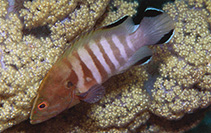| Family: |
Epinephelidae (Groupers) |
| Max. size: |
30 cm TL (male/unsexed); max. reported age: 11 years |
| Environment: |
reef-associated; marine; depth range 1 - 64 m, non-migratory |
| Distribution: |
Indo-West Pacific: Kenya to southern Mozambique eastward to the western Pacific. Reported from the Arafura Sea (Ref. 9819). Not reported from oceanic islands in the Indian Ocean, except for Aldabra, Comoros, Madagascar, and the Andaman and Lakshadweep islands. Unknown from the Red Sea, Persian Gulf, and from the islands of Micronesia except for Palau. Record from Rodriguez by Heemstra & Randall (1984, Ref. 3153) could not be verified and is probably erroneous (Ref. 33390). |
| Diagnosis: |
Dorsal spines (total): 9-9; Dorsal soft rays (total): 15-17; Anal spines: 3-3; Anal soft rays: 8-8. Brownish to greenish grey with dusky vertical bands over the body. White margins and black sub-margins on the median fins (Ref. 48635). Preopercle rounded, very finely serrate; no enlarged spines at angle, lower edge fleshy; characterized further by having ctenoid scales on body including abdomen; greatest depth of body 2.6-3.1 in SL; rounded caudal fin; pelvic fins not usually reaching anus, 1.6-2.1 in head length (Ref. 90102). |
| Biology: |
Mainly a coastal species (Ref. 48635). Inhabits silty dead reefs in protected waters. May also be seen on live coral (Ref. 089707). Secretive (Ref. 37816). Feeds mainly on fish (Ref. 30531) and crustaceans (Ref. 089707). Courtship and pair spawning were observed by Donaldson (1989, Ref. 6900). Diandric protogynous hermaphrodite (Ref. 45317). |
| IUCN Red List Status: |
Least Concern (LC); Date assessed: 16 November 2016 Ref. (130435)
|
| Threat to humans: |
harmless |
Source and more info: www.fishbase.org. For personal, classroom, and other internal use only. Not for publication.

